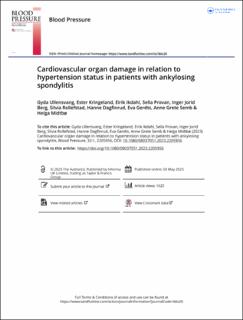Cardiovascular organ damage in relation to hypertension status in patients with ankylosing spondylitis
Ullensvang, Gyda; Kringeland, Ester Anne; Ikdahl, Eirik; Provan, Sella Aarrestad; Berg, Inger Jorid; Rollefstad, Silvia Christin Hellerud; Dagfinrud, Hanne; Gerdts, Eva; Semb, Anne Grete; Midtbø, Helga Bergljot
Journal article, Peer reviewed
Published version

Åpne
Permanent lenke
https://hdl.handle.net/11250/3090386Utgivelsesdato
2023Metadata
Vis full innførselSamlinger
- Department of Clinical Science [2295]
- Registrations from Cristin [9489]
Sammendrag
Purpose Hypertension is a major cardiovascular (CV) risk factor in ankylosing spondylitis (AS) patients. Less is known about the prevalence of CV organ damage in relation to hypertension status in AS patients. Materials and Methods CV organ damage was assessed by echocardiography, carotid ultrasound and pulse wave velocity (PWV) by applanation tonometry in 126 AS patients (mean age 49 ± 12 years, 39% women) and 71 normotensive controls (mean age 47 ± 11 years, 52% women). CV organ damage was defined as presence of abnormal left ventricular (LV) geometry, LV diastolic dysfunction, left atrial (LA) dilatation, carotid plaque or high pulse wave velocity (PWV). Results Thirty-four percent of AS patients had hypertension. AS patients with hypertension were older and had higher C-reactive protein (CRP) levels compared to AS patients without hypertension and controls (p < 0.05). The prevalence of CV organ damage was 84% in AS patients with hypertension, 29% in AS patients without hypertension and 30% in controls (p < 0.001). In multivariable logistic regression analyses, having hypertension was associated with a fourfold increased risk of CV organ damage independent of age, presence of AS, gender, body mass index, CRP, and cholesterol (odds ratio (OR) 4.57, 95% confidence interval (CI) 1.53 to 13.61, p = 0.006). In AS patients, presence of hypertension was the only covariable significantly associated with presence of CV organ damage (OR 4.40, 95% CI 1.40 to 13.84, p = 0.011). Conclusions CV organ damage in AS was strongly associated with hypertension, pointing to the importance of guideline-based hypertension management in AS patients.
